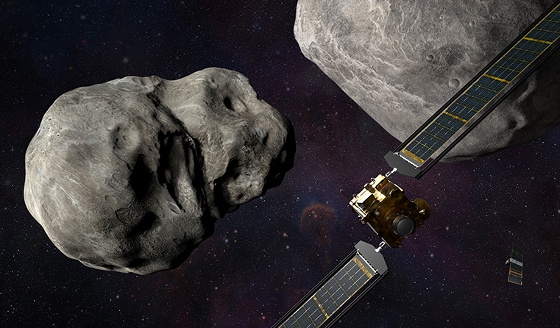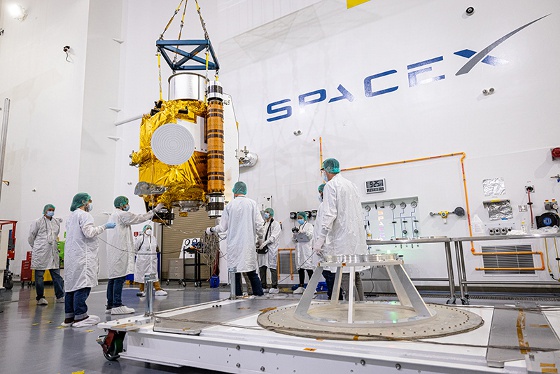 |
| September 20, 2022 | Volume 18 Issue 35 |
Designfax weekly eMagazine
Archives
Partners
Manufacturing Center
Product Spotlight
Modern Applications News
Metalworking Ideas For
Today's Job Shops
Tooling and Production
Strategies for large
metalworking plants
NASA will smash a spacecraft into an asteroid next week

Illustration of NASA's DART spacecraft and the Italian Space Agency's (ASI) LICIACube prior to impact at the Didymos binary system. [Credit: NASA/Johns Hopkins APL/Steve Gribben]
Can crashing a small spacecraft into an asteroid provide an effective means for planetary defense? NASA is aiming to find out next Monday, Sept. 26, when its DART (Double Asteroid Direction Test) mission slams into asteroid moonlet Dimorphos to see if -- and how far -- it can be moved.
The mission has been designed, developed, and managed by the Johns Hopkins Applied Physics Laboratory (APL) in Laurel, MD, for NASA's Planetary Defense Coordination Office. It is the world's first full-scale mission to test technology for defending the planet against potential asteroid or comet hazards.
DART has sent a spacecraft about the size of a small car to impact a known asteroid that is not a threat to Earth in order to see if it can change its motion in a way that can be measured accurately via ground-based telescopic observations. DART will show that a spacecraft can autonomously navigate to a target asteroid and intentionally collide with it. It's a method called kinetic impact, and the test will provide important data to help humankind better prepare for an asteroid that might post an impact hazard to Earth, should one ever be discovered.
DART was launched Nov. 24, 2021, from Space Launch Complex 4 East at Vandenberg Space Force Base in California.
DART's one-way trip is to the Didymos asteroid system, which comprises a pair of asteroids -- one small, the other large -- that orbit a common center of gravity. DART's target is the asteroid moonlet Dimorphos, which is approximately 530 ft (160 m) in diameter and orbits Didymos (which means "twin" in Greek), which is approximately 2,560 ft (780 m) in diameter (about a half-mile across). Since Dimorphos orbits the larger asteroid Didymos at a much slower relative speed than the pair orbits the Sun, the slight orbit change resulting from DART's kinetic impact within the binary system can be measured much more easily than a change in the orbit of a single asteroid around the Sun.
According to NASA, "The orbit of Didymos ranges from just outside the orbit of Earth (about 1 AU) to a bit beyond the orbit of Mars (about 2.27 AU) and is slightly inclined with respect to the plane of the planets (called the ecliptic), by about 3 degrees. It takes 2.11 years to make each trip around the Sun."
The asteroid binary system will be 6.8 million miles (11 million km) from Earth on the scheduled impact date. According to NASA, "The surface of Didymos cannot be seen in great detail from Earth, but scientists think it may be like the surfaces of similarly shaped asteroids that have been visited by spacecraft, like asteroids Bennu and Ryugu. Both of these asteroids have extremely rough surfaces full of boulders of various sizes. They lack the fine-grained regolith, or loose, dust-rich outer material, that is seen on Earth's Moon and on other asteroids."
The spacecraft will intercept the Didymos system Sept. 26, intentionally slamming into Dimorphos at roughly 4 miles per sec (6 km per sec) so that the spacecraft alters the asteroid's path around Didymos. Scientists estimate the kinetic impact will shorten Dimorphos' orbit by several minutes, and they will precisely measure that change using telescopes on Earth. The results will be used to both validate and improve scientific computer models that are critical to predicting the effectiveness of kinetic impact as a reliable method for asteroid deflection.

Get an idea of the size of the spacecraft. Here, DART is shown about one month before it launched in Nov. 2021. After moving to SpaceX's payload processing facility at Vandenberg Space Force Base in California, DART team members carefully removed the spacecraft from its shipping container and moved it to a low dolly. [Credit: NASA/Johns Hopkins APL/Ed Whitman]
A sophisticated guidance, navigation, and control (GNC) system, working with algorithms developed at APL called SMART Nav (Small-body Maneuvering Autonomous Real Time Navigation), will enable the DART spacecraft to identify and distinguish between the two asteroids and then, working in concert with the other GNC elements, direct the spacecraft toward Dimorphos, all within roughly an hour of impact.
The main element is the Didymos Reconnaissance and Asteroid Camera for Optical navigation (DRACO). According to APL, this is "the sensor that enables the intercept. A high-resolution camera derived from the New Horizons Long Range Reconnaissance Imager, DRACO's main jobs are to support spacecraft navigation and targeting toward the Didymos asteroid system; to measure the size and shape of the target asteroid, Didymos' small moon, Dimorphos; and to provide detailed views of the site where DART will slam into Dimorphos."
Provided by the Italian Space Agency, the Light Italian CubeSat for Imaging of Asteroids (LICIACube) will ride along with DART and be released prior to impact. LICIACube will then capture images of the DART impact, the resulting ejecta cloud, and possibly a glimpse of the impact crater on the surface of Dimorphos. It will also look at the back side of Dimorphos, gathering further data to enhance the kinetic models.
According to a NASA fact sheet on the mission, "DART is flying Deployable Space Systems Roll-Out Solar Arrays (ROSA) for the first time in deep space, featuring powerful APL-developed Transformational Solar Array concentrators. The arrays power NASA's Evolutionary Xenon Thruster - Commercial (NEXT-C) ion engine, an electric propulsion system developed by Glenn Research Center in collaboration with Aerojet Rocketdyne. The DART mission is demonstrating this new technology and maturing it for future missions."
Tune in to NASA TV on impact day (Sept. 26) for real-time updates on the mission. Live coverage will start at 6 pm EDT. There will also be a DRACO camera live feed from NASA here. The impact is scheduled for 7:14 p.m. EDT.
Sources: The Johns Hopkins University Applied Physics Laboratory, NASA
Published September 2022
Rate this article
View our terms of use and privacy policy
